

Decentralized Assets Like Gold and Bitcoin Are Looking More and More Attractive
As I see it, decentralized assets have never looked more attractive than they do now. That includes gold, silver and Bitcoin, and you could also make the case for collectibles like art.
By “decentralized,” I mean that these assets are not issued by a central authority. They are no one’s liability. No central banker makes the decision to mint more gold or silver. No finance minister decrees that Bitcoin production be slowed or accelerated.
Investors have been diversifying with gold and silver for decades to limit their exposure to poorly executed monetary and fiscal policies. As I shared with you last month, investors bought more American Eagle and American Buffalo gold coins between January and September of this year than in any other such period going back to 1999.
I believe this is largely a reflection of Americans’ souring opinion of the state of the economy and the imbalance they see in monetary and fiscal policies.
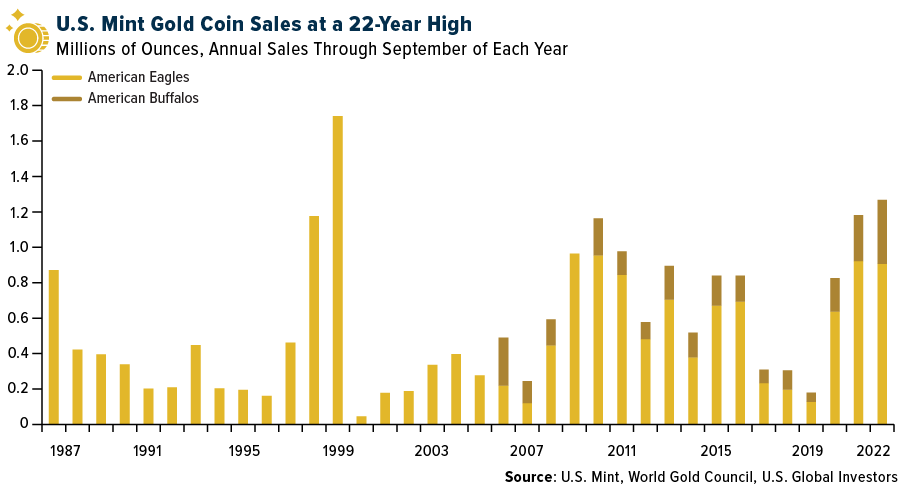
For the same reasons, more and more investors are also diversifying with Bitcoin, an asset whose payment system is based on “cryptographic proof instead of trust.” That’s from Satoshi Nakamoto’s Bitcoin whitepaper, released 14 years ago.
Satoshi’s point about trust is key to the idea of decentralization. As users of government-issued fiat currency, we have little choice but to trust policymakers’ economic and financial decisions, which may significantly impact the value of our money.
U.S. Spends More on Interest Than on Its Military
Take a look at where monetary and fiscal mismanagement has gotten us. Total U.S. debt now stands at an unfathomable $31 trillion, or around a quarter of a million dollars per U.S. taxpayer. Debt accounts for over 121% of the entire U.S. economy. That means for every dollar the U.S. has, it owes a buck and a quarter (almost).
Meanwhile, the Federal Reserve has been lifting interest rates at a pace we haven’t seen in 40 years, which makes servicing debt much more expensive. The amount of money the U.S. government pays on interest alone now exceeds its defense spending.
In the third quarter of 2022, the government paid over $736 billion just on interest. That’s more than its 2020 national defense budget of $714 billion.
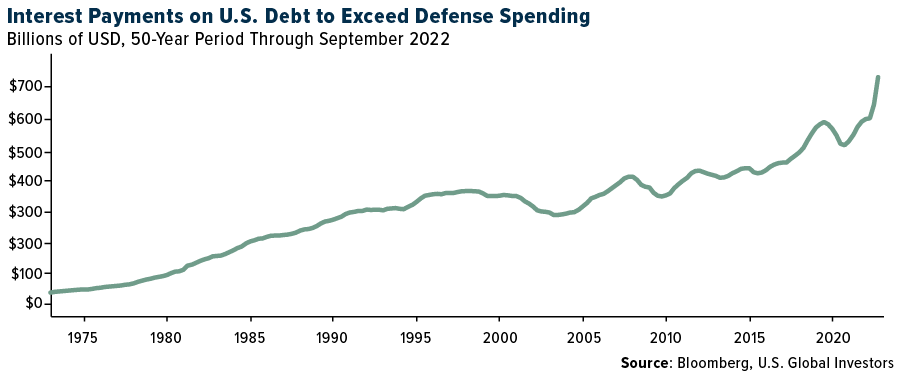
Central Banks Load Up on Gold
With gold, silver and Bitcoin, there’s no need for investors to put their trust in a third party or intermediary, especially one who may not have their best interests in mind.
What I find interesting is that central banks themselves—the ultimate central authorities—recognize the power in diversifying with decentralized assets. According to the World Gold Council (WGC), global central banks collectively added a record amount of gold during the third quarter. Purchases jumped to nearly 400 metric tonnes, more than double the amount compared to the previous quarter and a new quarterly record. With these purchases, the year-to-date total for 2022 now stands at 673 tonnes, higher than any other year since 1967, the WGC says.
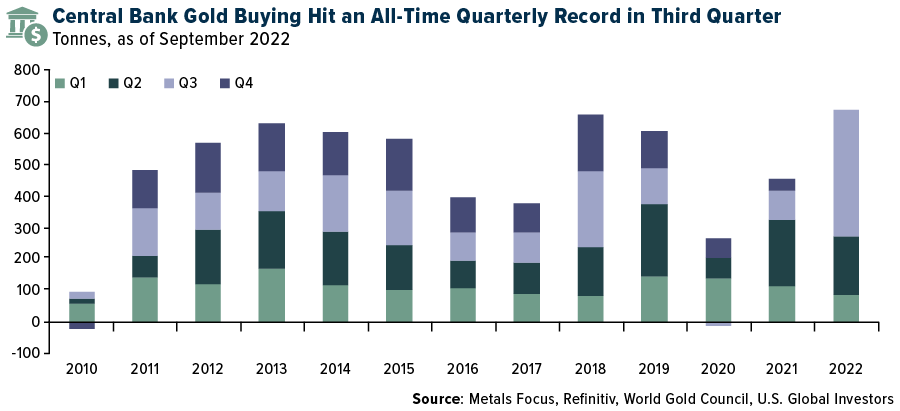
Gold Down for Record Seventh Month—a Buying Opportunity?
Gold’s critics and haters will point out that the price of precious metal has been down for seven straight months, a new all-time record, as of October.
They are correct. Due to rising interest rates and an historically strong U.S. dollar, gold has experienced a monthly losing streak unmatched since—are you ready for this?—1869.
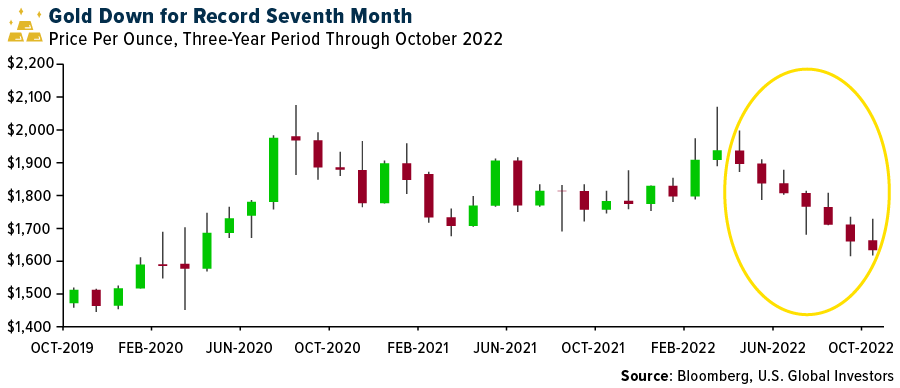
This sounds awful, but let’s put it in context. Through the end of October, gold has fallen 11% in 2022. The S&P 500, by comparison, has lost 18%.
What about other asset classes? Well, tech stocks (Nasdaq 100) have lost even more at around -30%. Emerging markets have done just as badly in 2022.
Treasury bonds are down 14%, corporate bonds are down 20%. Bitcoin is off 55% for the year.
So yes, the price of gold has declined for a record seven months, but it’s still beating close to everything else. That has to mean something.
For these reasons, I believe gold is priced very attractively, trading under $1,700 an ounce. The Fed will need to pivot at some point, and when it does, I think gold (and Bitcoin) could rally.
U.S. Global Investors Receives STAR Award for Overall Investor Education
I’m very pleased to share with you that U.S. Global Investors received two STAR Awards at this year’s Investment Management Education Alliance (IMEA) ceremony, held this week in New York City.
Competing in the small firm category, we took home the Investor Digital Experience award in recognition of our website redesign. We were also awarded top prize in Overall Investor Education for our content on Bitcoin and cryptocurrencies. I should point out that STAR Award entries are evaluated by a group of anonymous, impartial industry judges.
The rich educational content we produce at U.S. Global Investors is truly a group effort, and I commend the work of everyone in our talented marketing and investments teams.
If you like the work we produce and wish to support us, please consider subscribing to our newsletters today. And if you’ve already subscribed, thank you!
To subscribe to the Investor Alert, CLICK HERE.
To subscribe to Frank Talk, CLICK HERE.

Index Summary
- The major market indices finished down this week. The Dow Jones Industrial Average lost 1.40%. The S&P 500 Stock Index fell 3.58%, while the Nasdaq Composite fell 5.65%. The Russell 2000 small capitalization index lost 2.74% this week.
- The Hang Seng Composite gained 8.98% this week; while Taiwan was up 1.86% and the KOSPI rose 3.53%.
- The 10-year Treasury bond yield rose 16 basis points to 4.17%.
Airlines and Shipping
Strengths
- The best performing airline stock for the week was Finnair, up 17.1%. According to Bank of America, Frontier was one of the few carriers that did not update its third quarter 2022 guidance during the quarter. The airline’s third quarter 2022 earnings per share (EPS) of $0.15 came in ahead of Street estimates of $0.10. The beat was driven by better costs, while revenues of +35% versus 2019 came in slightly below Street estimates of +36%. For its 2023/2024 estimates, Frontier modestly lowered its capacity ramp to +28%/+14% year-over-year (from +30%/+15%).
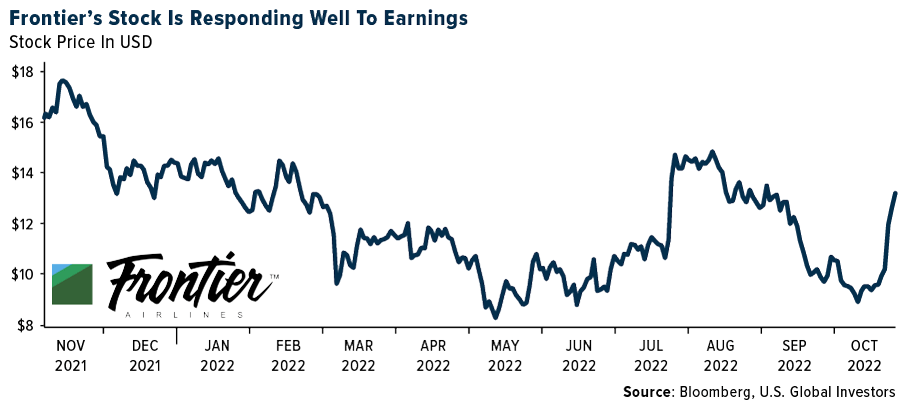
- LNG shipping rates continue to rise to previously unimaginable levels. Modern two-stroke vessels have spot rates approaching $500,000 per day, and there was a reported three-year time charter on a vessel not scheduled to be delivered for a full year from now, at $180,000 per day or more than twice the normal spot rate.
- In October, airline stocks gained 20.8% and outperformed the S&P 500 by 12.9%, which was the third best month over the past five years. The only months that were better include November 2020 when Covid vaccines were announced and February 2021 during the re-opening trade. Year-to-date, airlines are down 15.0% compared to the S&P 500 down 18.8%.
Weaknesses
- The worst performing airline stock for the week was Air France, down -6.5%. In China, per Flight Master, domestic pax volume/seat capacity further dropped to 24%/31% of 2019 levels from 27%/36% in the prior week. Domestic pax load factor slightly increased to 66% from 65% in the prior week. Daily aircraft utilization for narrow-body aircraft further dropped to 2.2 hours from 2.5 hours in the prior week.
- According to Goldman, global trade is declining at a pace only experienced in some of the deeper economic downturns. Apart from the more general economic slowdown, the bank believes this is reflective of the large pre-buy of durables during the pandemic, de-stocking, and weakness in Europe and China.
- According to Morgan Stanley, Boeing’s relative underperformance was driven by the substantial charges taken in the quarter on fixed-price development programs in Defense, a lower 2022 outlook for 737 MAX deliveries, and management commentary suggesting MAX deliveries at a rate in the low 30s into next year on supply chain constraints.
Opportunities
- International Airlines Group’s shareholders reached an agreement with Boeing to order 50 Boeing 737 MAX jets. IAG’s order is divided into 25 Boeing 737-8-200s and 25 Boeing 737-10s. Additionally, IAG has reserved the option to order an additional 100 jets of the 737 MAX family. Back in May, IAG announced the intention to purchase the 50 MAX jets with the option for another 100. However, the decision was subject to the approval of the group’s shareholders, which has now been confirmed.
- Ocean Network Express (ONE), a container vessel operator and an equity-accounted affiliate of three major Japanese shipping companies, announced that it has reached an agreement with Atlas for the acquisition proposal by a consortium including ONE. Atlas is an asset management company and owns Seaspan, the largest containership lessor. ONE’s equity stake in the consortium is not disclosed.
- Alaska Air’s management announced they are exercising options to purchase 52 Boeing 737 MAX aircraft, and secured rights for 105 additional planes through 2030. According to the press release, the airline could operate more than 250 new aircraft from the 737 MAX series family by 2030, and Alaska Air is on track to sunset Airbus aircraft by the end of 2023.
Threats
- Air France-KLM shares were down 15% following its earnings call because the company said it is interested in taking a position in TAP (Transportes Aereos Portugueses), which raises many questions about the strategic rationale of a potential transaction. Air France still plans a €1.2 billion hybrid bond to repay state aid, but this will not fully address negative equity of -€3 billion.
- According to Bank of America, COSCO Shipping’s third quarter 2022 net income declined 10% quarter-over-quarter with the 2022 peak season failing to arrive. The bank sees more downside into the fourth quarter, with profits forecast to be down 50% quarter-over-quarter, before additional pressure builds into 2023-2024, as heavy new deliveries and falling congestion weighs.
- Scheduled capacity has moved significantly for Hawaiian Airlines, with a 4.5% capacity reduction in the fourth quarter and a 7.6% reduction in the first quarter of 2023. Capacity reductions were related to Japan, with several routes being entirely removed into early 2023 including Honolulu to Sapporo, Honolulu to Fukuoka, and Kona to Tokyo. Hawaiian Airlines believes it can fully restore travel to Japan by the second quarter of 2023.
Emerging Markets
Strength
- The best performing country in emerging Europe for the week was Turkey, gaining 8.7%. The best performing country in Asia this week was Hong Kong, gaining 9.0%.
- The Hungarian forint was the best performing currency in emerging Europe this week, gaining 1.7%. The Thailand baht was the best performing currency in Asia this week, gaining 1.5%.
- Equites listed on the stock exchanges in mainland China and Hong Kong recorded strong gains in the past five days after reports emerged that China may be preparing to review its zero-covid policy and/or relax its aviation policy. Mid-week, these rumors were denied by the Chinse government; nevertheless, stocks gains. The Hong Kong Stock Exchange finished the week higher by 9% and shares trading on the Shanghai Stock Exchange surged 6.3%.
Weaknesses
- The worst performing country in emerging Europe for the week was Russia, losing 0.5%. The worst performing country in Asia this week was Malaysia, losing -0.5%.
- The Russian ruble was the worst performing currency in emerging Europe this week, losing 0.9%. The Indonesia rupiah was the worst performing currency in Asia this week, losing 1.0%.
- The Manufacturing PMI in the eurozone dropped to 46.4 in October from 48.4 in September. China recorded weaker Manufacturing PMI as well. The China Manufacturing PMI was reported at 49.0 in October down from 50.9 in September. However, the Caixin China PMI, which measures production activity among smaller, private firms, increased to 49.2 in October from 48.1 in the prior month, but remains below the 50-mark that separates growth from contraction.
Opportunities
- After the Chinese Communist Party meeting, Chinese policymakers reaffirmed once again this week that economic growth is still a priority and that they would press ahead with reforms. More support is expected to be announced for real estate and banking sector.
- On October 24, following an investor meeting in the United Kingdom, UBS published a report on Poland, which was titled “Is the worst now over?” The broker said that caution remains widespread among investors, but increased appetite for adding exposure in the region was noted due to valuations hovering around an all-time low. Next year’s elections in Poland could lead to a change in power, which would translate into a better relationship with the European Commission. The currently blocked Covid recovery funds could be unlocked. Year-to-date, Polish equites are the most oversold within the central emerging Europe region.
- Ukrainian forces can retake the strategic southern city of Kherson from Russian troops, U.S. Defense Secretary Lloyd Austin said on Thursday. Russia has fought for months to hang on to the Kherson region, which is strategically important for Russia’ war in Ukraine, providing Russia access to Crimea by land. Moscow had sent tens of thousands of troops to reinforce the area, one of its biggest battlefield priorities.
Threat
- The Federal Reserve hiked its main rate by another 75 basis points, and the central bank indicated it would continue to increase rates until its inflation target is met. The dollar sharply gained and most likely will remain trending higher, pushing emerging market currencies lower.
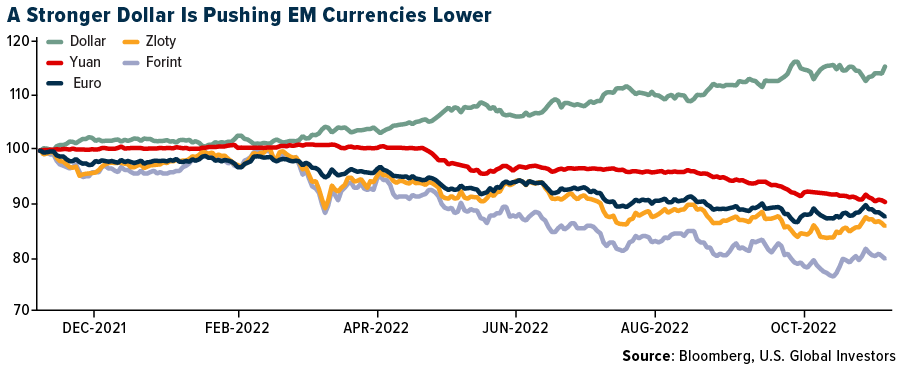
- Hong Kong’s gross domestic product (GDP) was reported much weaker than expected. Third-quarter GDP shrank 4.5% year-over-year versus expectations of a 0.8% decline. It is the third consecutive contraction and the weakest reading since the second quarter of 2020. Exports tumbled 15.5% and imports 16%.
- China once again is reporting a spike in Covid cases. On Thursday, China’s new Covid cases grew to 3,871 from 3,200 on Wednesday. The MGM casino in Macau was locked down with guests inside after Covid was found at the property. Rumors recently emerged that China may be willing to revise its zero-covid policy, but with Covid cases spiking again, it is unlikely.
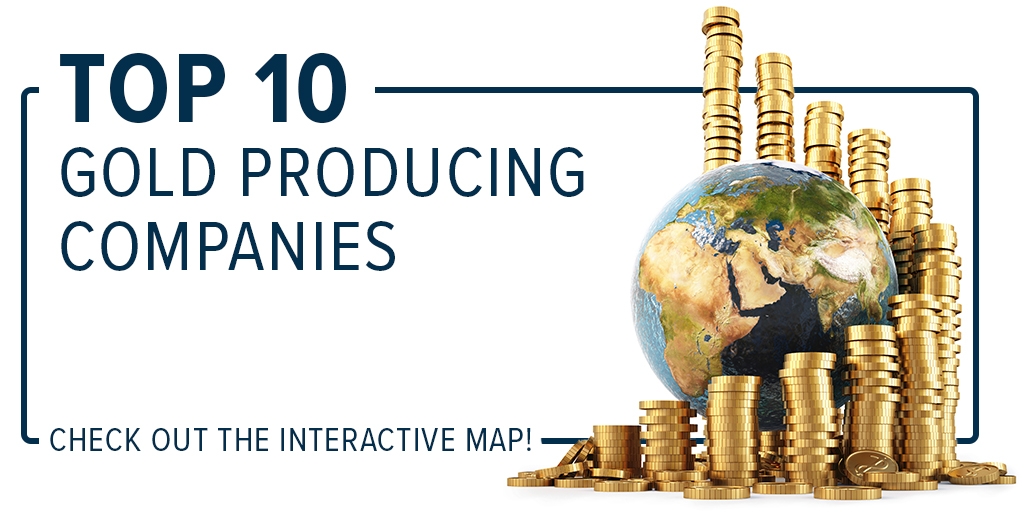
Energy and Natural Resources
Strengths
- The best performing commodity for the week was cotton, soaring 20.55% on speculation China will reopen its economy, atter setting a two-year low in prices on Monday. Since falling to $80 in late September, Brent crude oil has rallied 15% and stands back above $97. Near-term price dynamics continue to be distorted on multiple levels with the U.S. and Saudi Arabia vocally sparring after the recent OPEC+ cut that is expected to be 1.1 million barrels per day. But there is another consideration: the impact of the U.S. dollar. Over the past few weeks, the U.S. Dollar Index has seemingly rolled over. The effect on dollar-priced commodities appears obvious: A weaker dollar supports affordability in other currencies; it follows that if the dollar has peaked, oil may find another incremental tailwind in addition to all other supply-demand fundamentals that look increasingly pointed to tighter supply/demand fundamentals over the next year.
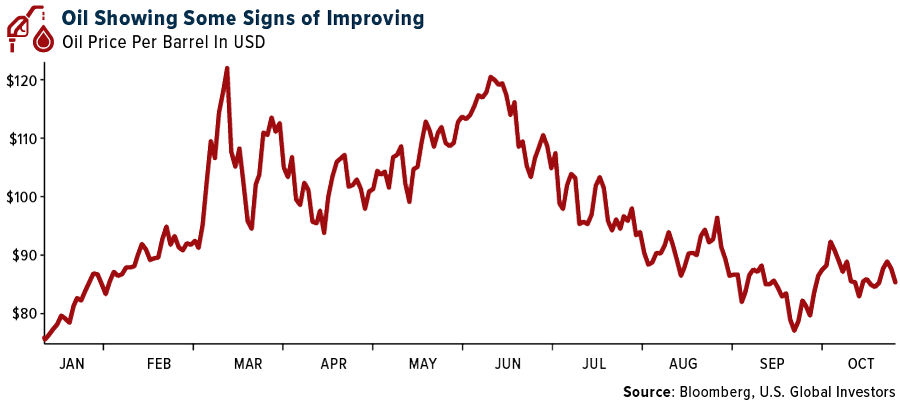
- Global offshore drilling is increasing. China and Saudi Arabia lead in contracted jackups, making up one-third of total jackup count, while Mexico, the UAE and India also have notable jackup counts. Furthermore, Saudi has announced plans to ramp to from 50 to 90 jackups by year-end 2024. North America/Southeast Asia jackup count fell the most alongside the downturn in 2015, but has risen 64%/45% since that trough.
- The oil market is tightening. Commercial crude inventories drew following last week’s build, by 3.115 million barrels, while the strategic petroleum reserve (SPR) drew by 1.926 million barrels. Cushing, Oklahoma, built for the fifth time in six weeks, by 1.267 million barrels. Cushing inventories are now 28.164 million barrels, at the bottom of the five-year range.
Weaknesses
- Eurostat, Europe’s gas usage was down 14% in August and 15% in September, in comparison to the five-year average of the month. The cuts were unevenly spread throughout the countries, as Germany cut its usage by 28% in August and 7.4% in September, while on the other hand Spain’s gas usage rose in both months. Dutch gas usage was down by a third while Italy also reduced its gas usage by 22% in September.
- Iron ore slumped more than 7% on Monday, reports Bloomberg, to touch its lowest since early 2019, extending a long rout as factory data in China added to demand pessimism. The raw material for steel is heading for its worst month in more than a year as China’s economy shows few signs of a decisive recovery and its steelmakers face deepening losses. China’s official gauge of factory activity for October missed estimates and pointed to a contraction; however, the reopening speculation rally saw iron finish the week with gain of nearly 2.5%.
- Zinc led a decline in industrial metals after a slump in China’s economic activity added to signs of weakening demand in the world’s No. 2 economy, writes Bloomberg, while a rebound in the dollar made commodities priced in the currency more expensive. Prices for the galvanizing metal slumped to the lowest since March 2021 after data on Monday showed China’s factories and services activity contracted as Covid curbs and the crisis in the property market continue to pressure the world’s biggest metals-consuming country. Zinc ended the week off more than 4%.
Opportunities
- Lead times of U.S. steel plate appear to be rising (again), reaching their highest level since January 2022, and potentially reflecting an uptick in service center activity level as they attempt to replenish stock ahead of the new year. Platts quoted one U.S. service center suggesting that their inventories have been worked down and they planned to return to the spot market. A higher-for-longer price environment could come as a positive surprise to the market.
- Schlumberger, has renamed itself SLB and notes they see an inflection point in the drilling service industry where there is a resurgence in oil and gas industry that is accelerating and demand for clean energy investment services are expected to grow for the next decade. SLB sees the next decade as a supercycle for the energy industry after years of lagging investment.
- Qatar plans to use its massive liquefied natural gas (LNG) expansion to transform the nation into the world’s top trader of the super-chilled fuel. “I think we will be one of the largest, if not the largest, LNG traders in the world,” Saad Al Kaabi, the nation’s energy minister and chief executive officer of state-owned Qatar Energy, said in an interview with Bloomberg TV.
Threats
- UBS is bearish on copper, as fundamentals universally point to a surplus in 2022. UBS is seeing some evidence of supply lifting. Risks to being short include the market is still tight and inventories are low, leaving markets vulnerable to a physical squeeze.
- Citigroup slashed its three-month iron ore price target to $70 per ton from an earlier estimate of $95, on weakening demand from Chinese steelmakers, it said in a note by analysts including Shreyas Madabushi.
- Coal is not going away yet. Despite burning coal being the biggest contributor of planet warming emissions, its use this year could set a record for generation of electricity for a second straight year, according to Bloomberg. Consumption has surged with the cutting of Russian gas, droughts curtaining hydro generation, and nuclear capacity not where it should be in Europe.
Luxury Goods
Strengths
- Ferrari, the luxury car maker, is enthusiastic about its prospect for this year and the next as the demand for its cars has been strong. Prices have increased despite the worldwide economic crisis because of the high inflation levels worldwide. Its core earnings rose 17% for the third quarter to 435 million euros. China, Hong Kong and Taiwan were the regions with the most significant shipment growth of 73%.
- According to Bloomberg, the University of Michigan Consumer Sentiment Index, which tracks consumer behavior related to discretionary expenditures, increased slightly in October. It was reported at 59.9 vs. a consensus of 59.6 and a previous month’s reading of 59.8.
- MGM China Holdings, a company that owns luxury resorts, hotels and casinos in Macau, China, was the best-performing S&P Global Luxury stock for the week, gaining 32.48%. In the third quarter report of the year, the company reported a revenue rose of 26% year-on-year to $3.4 billion. This result was boosted by a higher business volume in their resort in Las Vegas and the acquisition of the Cosmopolitan and Aria Casino hotels in May this year.
Weaknesses
- According to Bloomberg, the China Manufacturing PMI Index decreased to 49 in October from 50.9 in September. The manufacturing activity dropped into contractor territory, below the 50-mark.
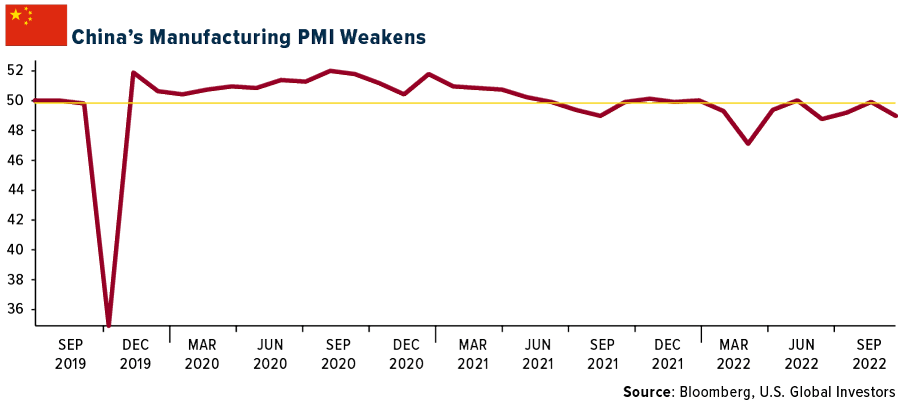
- Aston Martin is concerned about the global supply chain’s higher cost and logistic disruption because it is affecting its profit margins this year. In the third quarter, despite its revenue increasing by 33% thanks to an increase in selling prices of 28%, the higher cost outweighed the benefits of the revenue. Its operating loss increased 89% to 55 million euros from 29.1 million euros. The company also said it will have 400 unfinished vehicles waiting on parts and an inventory cost of 106 million euros by the end of 2022. According to Bloomberg, its stock has fallen around 85% last year.
- Sleep Number, a company that designs, manufactures and markets a line of air bed mattresses and bed accessories in the U.S., was the worst-performing S&P Global Luxury stock losing 13%. The stock hit a 52-week low this week at $24,98 and has declined 67.4% year-to-date.
Opportunities
- Millions of metaverse users are designing virtual clothing and accessories for its virtual world, and a lot of customers are willing to pay for these items to dress their avatars, according to Business of Fashion. Roblox said over 11.5 million creators are creating more than 62 million items on the metaverse. It represents an increase of 25% from 2021. The primary consumers are Generation Z. The main challenge is making virtual clothing look as good as its physical version. But it shows an excellent opportunity for luxury brands to keep trying to get into this world and attract this significant consumer segment, Gen-Z.
- In collaboration with Fortnite Epic Games, Ralph Laurent offers a new experience to its consumers focused on the future and its iconic Polo Pony logo was redesigned for the first time in 55 years to commemorate the partnership. It will also start with digital apparel and accessories on the Fornite Item Shop as the physical option, emphasizing the interplay between the digital and physical worlds. It’s the first approach of the brand in the digital exploration world that comes to stay in the fashion industry.
- According to Bloomberg Intelligence, Hermès’ revenue by 2024 could reach 15 billion euros, more than doubling in five years. The top luxury positioning of the company contributes to the pricing and operating margin superiority, along with the plan to open five new leather factories by 2026, representing an expansion in production capacity of 20%.
Threats
- According to Bloomberg economists, the month-over-month inflation in United Sates is expected to increase from 0.4% in the previous month to 0.7% in October. It could represent a decrease in the purchasing power of customers in the United States, one of the leading luxury goods markets. It may also provide a green light to the Federal Reserve to increase interest rates to fight the high inflation levels.
- The world’s biggest iPhone producer, Foxconn’s Zhengzhou factory, has been on lockdown, highlighting the high risk that China’s zero-covid policy could affect the manufacturing sector and the supply chain worldwide. This factory is the leading Apple subcontractor and the biggest private sector employer in China, with more than a million workers across the country. Apple manufactures more than 90% of its products in China, and now the company must look for new manufacturers in countries like India.
- In China, one of the leading luxury goods markets worldwide, the National Health Commission reconfirmed this week that China will not change its zero-covid policy for now and ordered that all officials commit to it. We expect more lockdowns to continue throughout the country, threatening the local economy and the global supply chain.
Blockchain and Digital Currencies
Strengths
- Of the cryptocurrencies tracked by CoinMarketCap, the best performer for the week was Loopring, rising 45.35%.
- India’s central bank started a pilot program of its digital currency on Tuesday, allowing select banks to use it for settling secondary-market transactions in government securities. Banks traded 2.75 billion rupees of bonds on the first day using the new form of currency. The e-rupee will be tested for retail use within a month in some locations, the Central Bank of India said according to an article published by Bloomberg.
- Supporters of the Cosmos blockchain are betting a revamp of the popular crypto protocol will boost the value of its native token amid the current digital-asset bear market. Similar to the newly upgraded Ethereum Blockchain, Cosmos uses proof-of-stake (PoS) mechanism to verify transactions, meaning that users, or so-called validators, can put their Atom tokens to secure the network.
Weaknesses
- Of the cryptocurrencies tracked by CoinMarketCap, the worst performing for the week was Aptos, down 11.92%.
- A group of Core Scientific convertible bondholders has tapped Moelis & Co. to facilitate debt talks with struggling Bitcoin miner according to people with knowledge of the situation. Core Scientific has said it wouldn’t make payment due in late October and early November tied to some of its debts. Those creditors could accelerate payment, sue the company for nonpayment or take other actions which could then lead to default under a pair of convertible notes due 2025.
- Robinhood Markets reported Wednesday that its crypto transaction revenue fell to $51 million during the third quarter, a 12% decline compared to the previous quarter and below analysts’ estimates of $56.1 million. Other companies have also suffered amid a sharp drop in crypto prices, as the industry continues to be battered by the collapse of major blockchain platforms, scams and layoffs writes Bloomberg.
Opportunities
- Hong Kong laid out a master plan to become a top Asian crypto hub offering legalized retail trading and digital-asset exchange-traded funds part of a wider push to restore the city’s credential as a financial center. A consultation will begin on how the retail segment “may be given a suitable degree of access” to tokens. The city invited global crypto exchanges to explore opportunities, adding that work toward a new virtual-asset licensing regime is intensifying.
- A parabolic surge in meme cryptocurrency Dogecoin over the past week is encouraging speculation that other so-called alt-coins could also catch a speculative tailwind. The coin represented by an image of a Shiba Inu climbed to almost $0.15 from roughly $0.06 over the period, an advance that in percentage terms far outstrips the performance of top token Bitcoin.
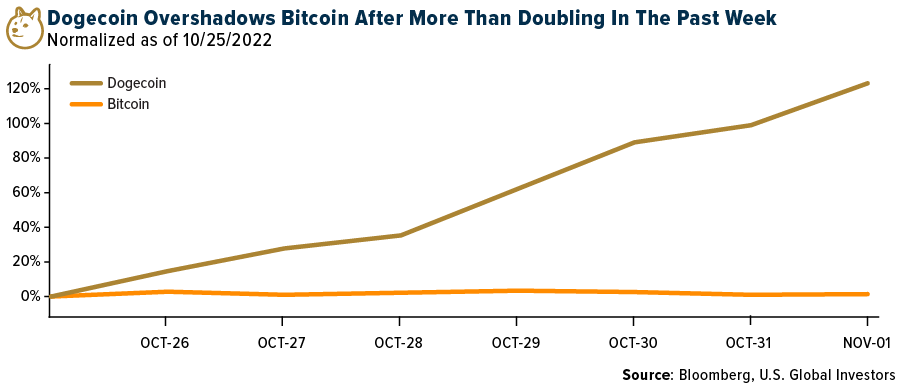
- The crypto bulls are back with Bitcoin edging toward the higher end of its monthslong trading range. Smaller tokens such as Polygon, Litecoin and Solana also outperformed the digital-asset benchmark.
Threats
- Bitcoin miner Argo Blockchain warned that it could be forced to shut down after a $27 million share sale appeared to have collapsed, sending the stock plummeting the most since its 2018 IPO. The stock dropped as much as 73% in London on Monday and has fallen about 90% this year as a slump in cryptocurrency prices roiled the mining industry.
- The IRS criminal Investigation unit seized about $7 billion in cryptocurrency in 2022, double the previous year’s total, an agency official said Tuesday. The investigations unit identified $32 billion in fraud this year, three times the amount from the previous year, said Jim Lee the IRS chief of Criminal investigation, writes Bloomberg.
- Hackers inflicted more pain on the cryptocurrency sector by looting $28 million from derivatives exchange Deribit. A wallet connected to the internet was compromised Tuesday, Deribit said on Twitter. Deribit, one of the largest derivatives exchanges in crypto, is the latest victim in an ever-lengthening list of security incidents at crypto projects and protocols, writes Bloomberg.

Gold Market
This week gold futures closed at $1,683.50 up $38.70 per ounce, or 2.35%. Gold stocks, as measured by the NYSE Arca Gold Miners Index, ended the week lower by 0.21%. The S&P/TSX Venture Index came in off 0.54%. The U.S. Trade-Weighted Dollar was flat.
| Date | Event | Survey | Actual– | Prior |
|---|---|---|---|---|
| Oct-31 | Eurozone CPI Core YoY | 5.0% | 5.0% | 4.8% |
| Oct-31 | Caixin China PMI Mfg | 48.5 | 49.2 | 48.1 |
| Nov-1 | ISM Manufacturing | 50.0 | 50.2 | 50.9 |
| Nov-2 | ADP Employment Change | 185k | 239k | 192k |
| Nov-2 | FOMC Rate Decision (Upper Bound) | 4.00% | 4.0% | 3.25% |
| Nov-3 | Initial Jobless Claims | 220k | 217k | 218k |
| Nov-3 | Durable Goods Orders | 0.4% | 0.4% | 0.4% |
| Nov-4 | Change in Nonfarm Payrolls | 193k | 261k | 315k |
| Nov-10 | CPI YoY | 7.9% | — | 8.2% |
| Nov-10 | Initial Jobless Claims | 220k | — | 217k |
| Nov-11 | Germany CPI YoY | 10.4% | — | 10.4% |
Strengths
- The best performing precious metal for the week was silver, up 9.34% largely on speculation that China will reopen soon. According to BMO, Agnico Eagle reported financial results that are in line with, or better than, consensus expectations. For example, adjusted earnings per share (EPS) came in at $0.52 versus the consensus $0.43-$0.44, by outperforming on sales and all-in sustaining costs (AISC).
- India’s gold demand has reached pre-pandemic levels and has witnessed an annual growth of 14% during the July-September quarter, at 191.7 tons, mainly driven by strong consumer interest, according to a World Gold Council (WGC) report. The total demand stood at 168 tons during the July-September quarter of 2021.
- Central banks bought a record amount of gold last quarter as they diversified foreign currency reserves, with a large chunk of the purchases coming from as-yet unknown buyers. Almost 400 tons were scooped up by central banks in the
third quarter, more than quadruple the amount a year earlier, according to the WGC. That takes the total so far this year to the highest since 1967, when the dollar was still backed by the metal.
Weaknesses
- The worst performing precious metal for the week was palladium, down 1.86%, perhaps on recession fears. Newcrest Mining reported first quarter 2023 results which featured lower-than-expected production of 527,000 ounces of gold at an AISC that was roughly in line with expectations at $1,098 per ounce. The company mainly attributes the lower production results to its planned maintenance shutdowns during the quarter, lower achieved grades and drought conditions specific to Lihir.
- Eldorado Gold reported third quarter operating and financial results after pre-reporting production of approximately 118,000 ounces earlier this month. Overall, the quarter came with higher cash costs, compounded by a lower realized gold price, and higher income tax expenses, driving a miss to the below-consensus expectations. Production guidance of 460-490,000 ounces was reiterated, with the company tracking to the low-end of the guidance range. Cash cost and AISC guidance have been maintained; however, year-to-date costs are tracking higher than the top-end of guidance, with total cash costs and AISC tracking $62 per ounce and $9 per ounce above the top-end of the respective ranges.
- Gold headed for its seventh straight month of declines, the longest losing streak since at least the late 1960s, ahead of yet another expected jumbo rate hike by the Federal Reserve. The metal extended its October slump on Monday as the dollar and Treasury yields rebounded from last week’s loss amid weakness in equity markets. Attention is now firmly on the Fed, whose aggressive rate hikes have caused bullion to drop more than a fifth from its March peak.
Opportunities
- Silver consumption in India is seeing a rebound in 2022 and is having an impact on its price. Local purchases last year in India were about 4,500 tons but may surpass 8,000 tons, reports Bloomberg. The accelerated purchases have drained the London vaults to 27,101 tons at the end of September, the lowest since records began in 2016. The Perth Mint reported that demand for its gold kilogram bars from Chinese institutional investors have remained at healthy levels over the past two or three months. The imbalance between gold demand and supply in China has the Shanghai gold premium trading about $20 above international prices.
- Are we there yet? U.S. two-year Treasury bond yields peaked at 4.6% in October, in line with the terminal Federal Funds Rate suggested by the September dot plot. The Fed pauses in 2006 and 2018 marked potent entry points for bullion and gold equities. A replay may be in the cards, but risk-averse investors should wait for an inversion of the two-year/three-month bond yield curve as confirmation that a Fed pivot is imminent. However, the large undisclosed central bank gold buying recently, paired with strong institutional demand from Asia, indicates they are not waiting for a Fed pivot.
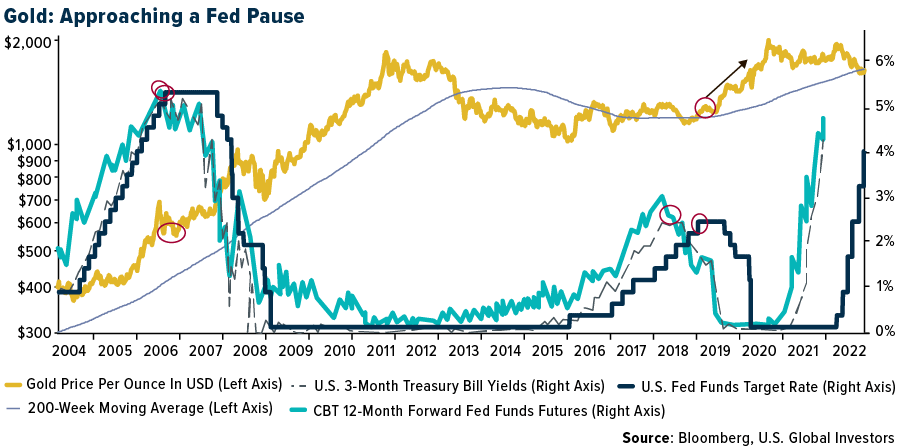
Threats
- Peru’s community of Casma Palla Palla threatened to carry out more protests against Hochschild’s Immaculada mine after 30 protestors burned buildings and attacked company officials at the site earlier in the week.
- Silver Lake Resources’ first quarter 2023 production of 59,000 ounces was 6% below expectations, while group AISC of A$2,052 per ounce was 4% higher. Deflector’s production was the key area of weakness with the company noting that lower-grade stopes were mined during the quarter with the mine also having planned shutdowns.
- UBS forecasts Barrick Gold’s net-cash to fall to $400 million in the third quarter and fall again in the fourth quarter, triggering a $0.05 per share decline in the quarterly dividend. Newmont is more complicated, as management envisions reworking both the gold price and cost considerations in its framework, but there may not be an update before the December guidance call. On a simplified basis, the company could cut its dividend by 20%; that said, maintaining the current payout is not out of the question.

U.S. Global Investors, Inc. is an investment adviser registered with the Securities and Exchange Commission (“SEC”). This does not mean that we are sponsored, recommended, or approved by the SEC, or that our abilities or qualifications in any respect have been passed upon by the SEC or any officer of the SEC.
This commentary should not be considered a solicitation or offering of any investment product. Certain materials in this commentary may contain dated information. The information provided was current at the time of publication. Some links above may be directed to third-party websites. U.S. Global Investors does not endorse all information supplied by these websites and is not responsible for their content. All opinions expressed and data provided are subject to change without notice. Some of these opinions may not be appropriate to every investor.
Holdings may change daily. Holdings are reported as of the most recent quarter-end. The following securities mentioned in the article were held by one or more accounts managed by U.S. Global Investors as of (09/30/22):
Agnico Eagle Mines
Eldorado Gold Corp.
Barrick Gold
Newmont Corp.
Silver Lake Resources
Boeing Co/The
Alaska Air
Airbus SE
Air France-KLM
Hawaiian Holdings Inc.
COSCO Shipping Holdings
Ferrari NV
Ralph Lauren Corp.
Hermes International
*The above-mentioned indices are not total returns. These returns reflect simple appreciation only and do not reflect dividend reinvestment.
The Dow Jones Industrial Average is a price-weighted average of 30 blue chip stocks that are generally leaders in their industry. The S&P 500 Stock Index is a widely recognized capitalization-weighted index of 500 common stock prices in U.S. companies. The Nasdaq Composite Index is a capitalization-weighted index of all Nasdaq National Market and SmallCap stocks. The Russell 2000 Index® is a U.S. equity index measuring the performance of the 2,000 smallest companies in the Russell 3000®, a widely recognized small-cap index.
The Hang Seng Composite Index is a market capitalization-weighted index that comprises the top 200 companies listed on Stock Exchange of Hong Kong, based on average market cap for the 12 months. The Taiwan Stock Exchange Index is a capitalization-weighted index of all listed common shares traded on the Taiwan Stock Exchange. The Korea Stock Price Index is a capitalization-weighted index of all common shares and preferred shares on the Korean Stock Exchanges.
The Philadelphia Stock Exchange Gold and Silver Index (XAU) is a capitalization-weighted index that includes the leading companies involved in the mining of gold and silver. The U.S. Trade Weighted Dollar Index provides a general indication of the international value of the U.S. dollar. The S&P/TSX Canadian Gold Capped Sector Index is a modified capitalization-weighted index, whose equity weights are capped 25 percent and index constituents are derived from a subset stock pool of S&P/TSX Composite Index stocks. The NYSE Arca Gold Miners Index is a modified market capitalization weighted index comprised of publicly traded companies involved primarily in the mining for gold and silver. The S&P/TSX Venture Composite Index is a broad market indicator for the Canadian venture capital market. The index is market capitalization weighted and, at its inception, included 531 companies. A quarterly revision process is used to remove companies that comprise less than 0.05% of the weight of the index, and add companies whose weight, when included, will be greater than 0.05% of the index.
The S&P 500 Energy Index is a capitalization-weighted index that tracks the companies in the energy sector as a subset of the S&P 500. The S&P 500 Materials Index is a capitalization-weighted index that tracks the companies in the material sector as a subset of the S&P 500. The S&P 500 Financials Index is a capitalization-weighted index. The index was developed with a base level of 10 for the 1941-43 base period. The S&P 500 Industrials Index is a Materials Index is a capitalization-weighted index that tracks the companies in the industrial sector as a subset of the S&P 500. The S&P 500 Consumer Discretionary Index is a capitalization-weighted index that tracks the companies in the consumer discretionary sector as a subset of the S&P 500. The S&P 500 Information Technology Index is a capitalization-weighted index that tracks the companies in the information technology sector as a subset of the S&P 500. The S&P 500 Consumer Staples Index is a Materials Index is a capitalization-weighted index that tracks the companies in the consumer staples sector as a subset of the S&P 500. The S&P 500 Utilities Index is a capitalization-weighted index that tracks the companies in the utilities sector as a subset of the S&P 500. The S&P 500 Healthcare Index is a capitalization-weighted index that tracks the companies in the healthcare sector as a subset of the S&P 500. The S&P 500 Telecom Index is a Materials Index is a capitalization-weighted index that tracks the companies in the telecom sector as a subset of the S&P 500.
The Consumer Price Index (CPI) is one of the most widely recognized price measures for tracking the price of a market basket of goods and services purchased by individuals. The weights of components are based on consumer spending patterns. The Purchasing Manager’s Index is an indicator of the economic health of the manufacturing sector. The PMI index is based on five major indicators: new orders, inventory levels, production, supplier deliveries and the employment environment. Gross domestic product (GDP) is the monetary value of all the finished goods and services produced within a country’s borders in a specific time period, though GDP is usually calculated on an annual basis. It includes all private and public consumption, government outlays, investments and exports less imports that occur within a defined territory.
The S&P Global Luxury Index is comprised of 80 of the largest publicly traded companies engaged in the production or distribution of luxury goods or the provision of luxury services that meet specific investibility requirements.
There is no guarantee that the issuers of any securities will declare dividends in the future or that, if declared, will remain at current levels or increase over time.
A basis point, or bp, is a common unit of measure for interest rates and other percentages in finance. One basis point is equal to 1/100th of 1%, or 0.01% (0.0001).
The U.S. Dollar Index is an index of the value of the United States dollar relative to a basket of foreign currencies, often referred to as a basket of U.S. trade partners’ currencies.
The NASDAQ-100 Index is a modified capitalization-weighted index of the 100 largest and most active non-financial domestic and international issues listed on the NASDAQ.
Surveys of Consumers collects data on consumer attitudes and expectations summarized in the Consumer Sentiment, in order to determine the changes in consumers’ willingness to buy and to predict their subsequent discretionary expenditures. This Index is comprised of measures of attitudes toward personal finances, general business conditions, and market conditions or prices.






























